towing TOYOTA COROLLA 2022 Owners Manual (in English)
[x] Cancel search | Manufacturer: TOYOTA, Model Year: 2022, Model line: COROLLA, Model: TOYOTA COROLLA 2022Pages: 678, PDF Size: 147.24 MB
Page 4 of 678
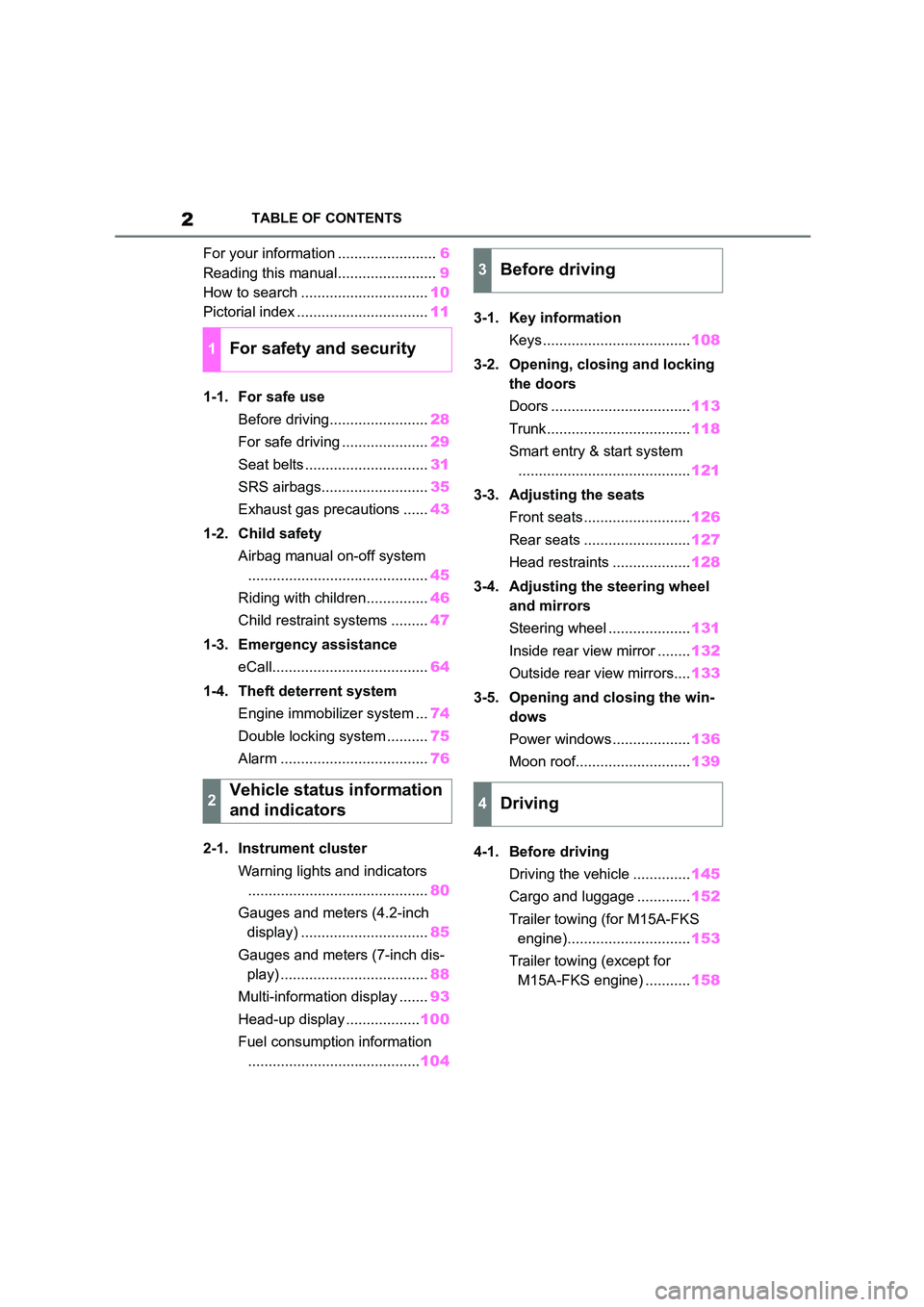
2TABLE OF CONTENTS
For your information ........................6
Reading this manual........................ 9
How to search ............................... 10
Pictorial index ................................ 11
1-1. For safe use
Before driving........................ 28
For safe driving ..................... 29
Seat belts .............................. 31
SRS airbags.......................... 35
Exhaust gas precautions ...... 43
1-2. Child safety
Airbag manual on-off system
............................................ 45
Riding with children............... 46
Child restraint systems ......... 47
1-3. Emergency assistance
eCall...................................... 64
1-4. Theft deterrent system
Engine immobilizer system ... 74
Double locking system .......... 75
Alarm .................................... 76
2-1. Instrument cluster
Warning lights and indicators
............................................ 80
Gauges and meters (4.2-inch
display) ............................... 85
Gauges and meters (7-inch dis-
play) .................................... 88
Multi-information display ....... 93
Head-up display .................. 100
Fuel consumption information
.......................................... 104
3-1. Key information
Keys .................................... 108
3-2. Opening, closing and locking
the doors
Doors .................................. 113
Trunk................................... 118
Smart entry & start system
.......................................... 121
3-3. Adjusting the seats
Front seats .......................... 126
Rear seats .......................... 127
Head restraints ................... 128
3-4. Adjusting the steering wheel
and mirrors
Steering wheel .................... 131
Inside rear view mirror ........ 132
Outside rear view mirrors.... 133
3-5. Opening and closing the win-
dows
Power windows ................... 136
Moon roof............................ 139
4-1. Before driving
Driving the vehicle .............. 145
Cargo and luggage ............. 152
Trailer towing (for M15A-FKS
engine).............................. 153
Trailer towing (except for
M15A-FKS engine) ........... 158
1For safety and security
2Vehicle status information
and indicators
3Before driving
4Driving
Page 15 of 678
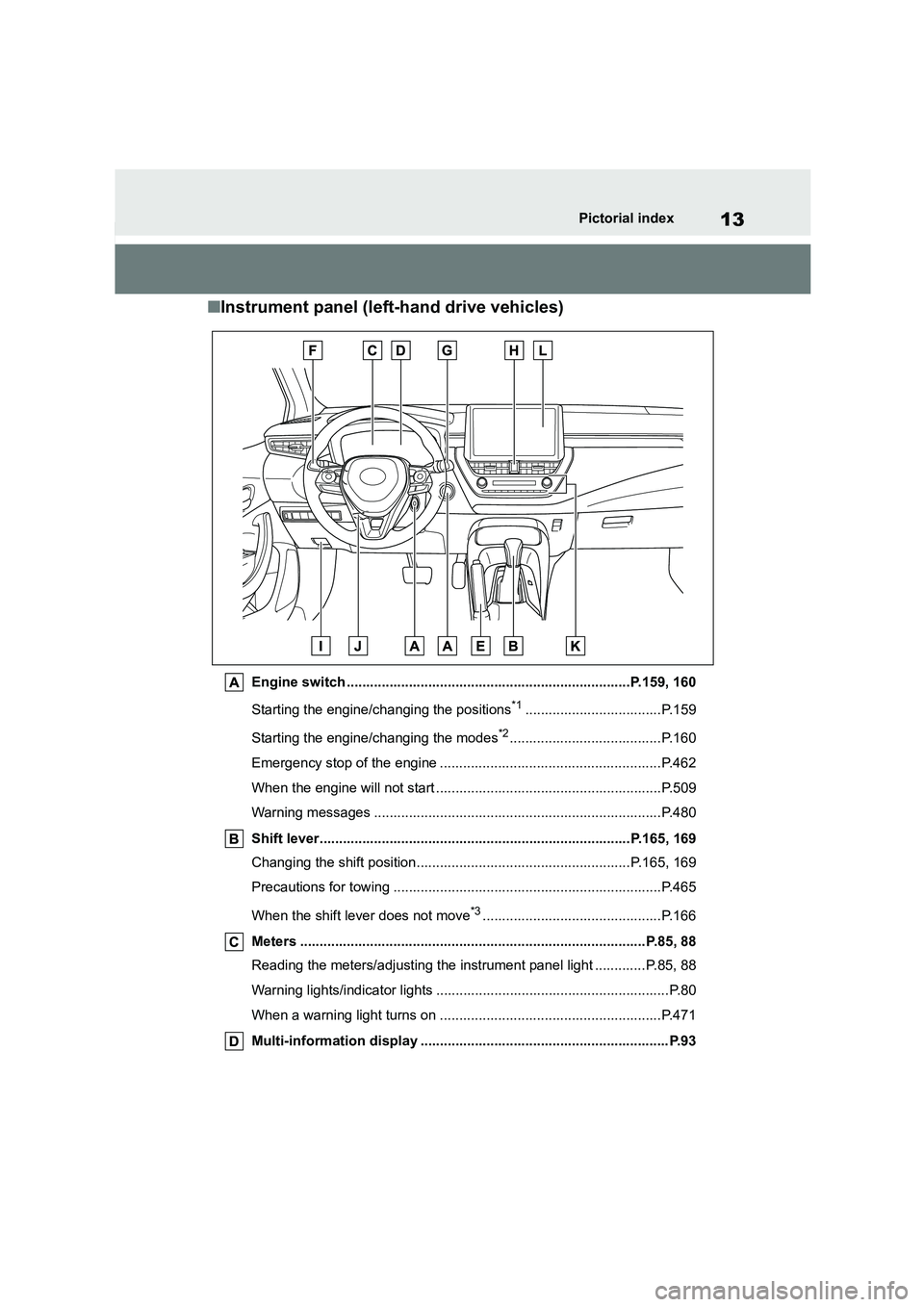
13Pictorial index
■Instrument panel (left-hand drive vehicles)
Engine switch .........................................................................P.159, 160
Starting the engine/changing the positions*1...................................P.159
Starting the engine/changing the modes*2.......................................P.160
Emergency stop of the engine .........................................................P.462
When the engine will not start ..........................................................P.509
Warning messages ..........................................................................P.480
Shift lever................................................................................P.165, 169
Changing the shift position.......................................................P.165, 169
Precautions for towing .....................................................................P.465
When the shift lever does not move*3..............................................P.166
Meters .........................................................................................P.85, 88
Reading the meters/adjusting the instrument panel light ............. P.85, 88
Warning lights/indicator lights ............................................................P.80
When a warning light turns on .........................................................P.471
Multi-information display ................................................................P.93
Page 22 of 678
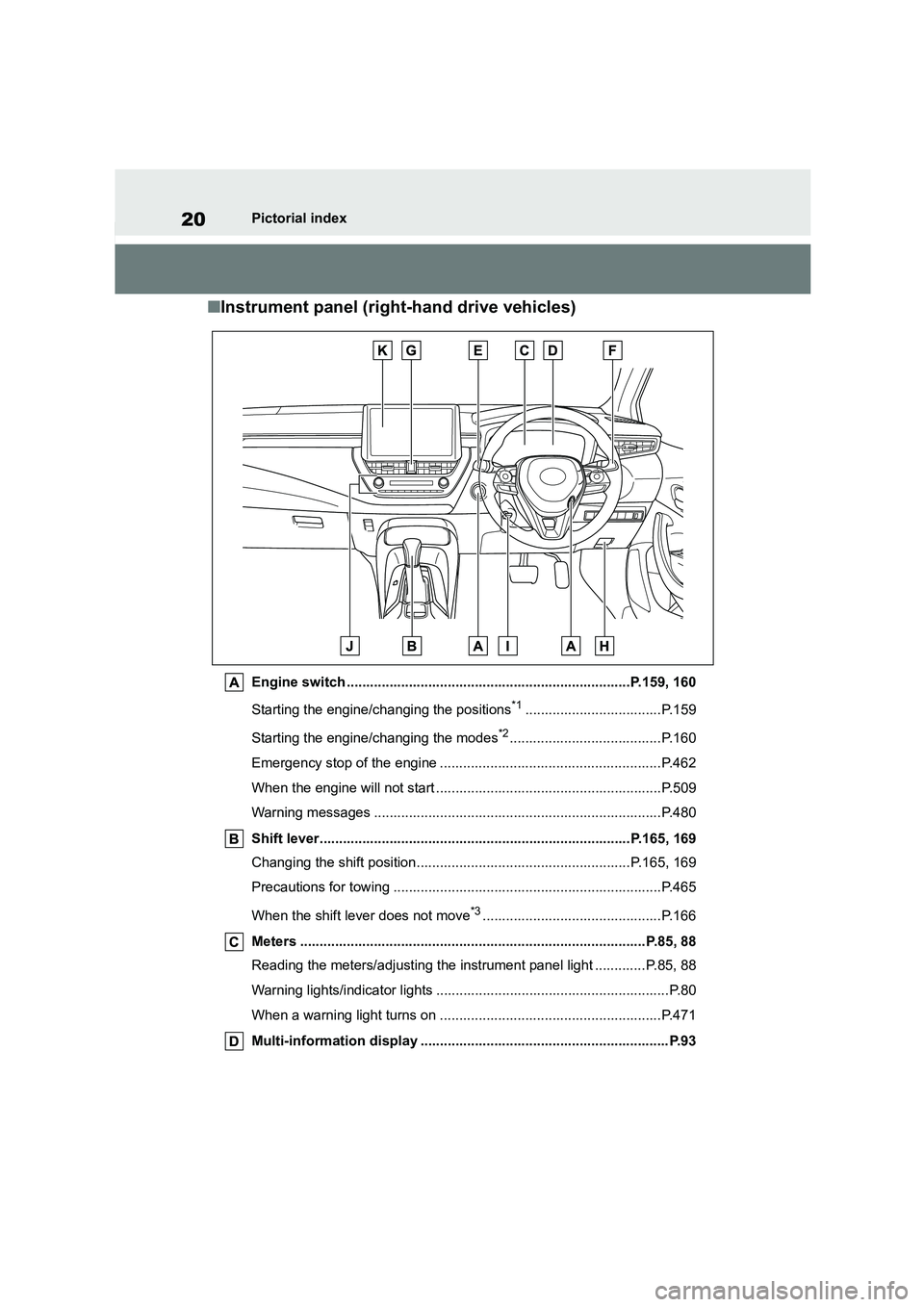
20Pictorial index
■Instrument panel (right-hand drive vehicles)
Engine switch .........................................................................P.159, 160
Starting the engine/changing the positions*1...................................P.159
Starting the engine/changing the modes*2.......................................P.160
Emergency stop of the engine .........................................................P.462
When the engine will not start ..........................................................P.509
Warning messages ..........................................................................P.480
Shift lever................................................................................P.165, 169
Changing the shift position.......................................................P.165, 169
Precautions for towing .....................................................................P.465
When the shift lever does not move*3..............................................P.166
Meters .........................................................................................P.85, 88
Reading the meters/adjusting the instrument panel light ............. P.85, 88
Warning lights/indicator lights ............................................................P.80
When a warning light turns on .........................................................P.471
Multi-information display ................................................................P.93
Page 62 of 678
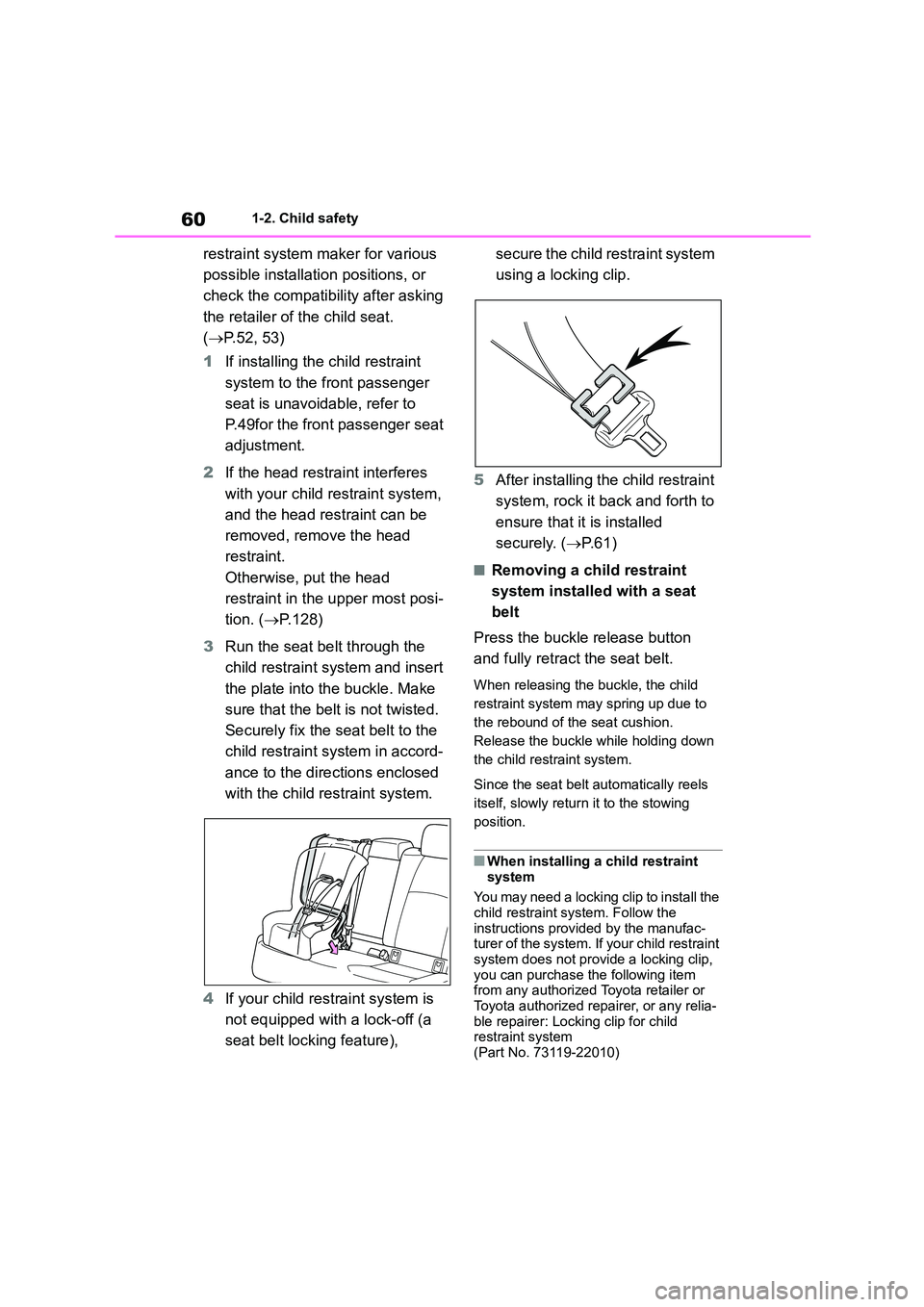
601-2. Child safety
restraint system maker for various
possible installation positions, or
check the c ompatibility after asking
the retailer of the child seat.
( P.52, 53)
1 If installing the child restraint
system to the front passenger
seat is unavoidable, refer to
P.49for the front passenger seat
adjustment.
2 If the head restraint interferes
with your child restraint system,
and the head restraint can be
removed, remove the head
restraint.
Otherwise, put the head
restraint in the upper most posi-
tion. ( P.128)
3 Run the seat belt through the
child restraint system and insert
the plate into th e buckle. Make
sure that the belt is not twisted.
Securely fix the seat belt to the
child restraint s ystem in accord-
ance to the directions enclosed
with the child restraint system.
4 If your child restraint system is
not equipped with a lock-off (a
seat belt locking feature),
secure the child restraint system
using a locking clip.
5 After installing the child restraint
system, rock it back and forth to
ensure that it is installed
securely. ( P. 6 1 )
■Removing a child restraint
system installed with a seat
belt
Press the buckle release button
and fully retract the seat belt.
When releasing the buckle, the child
restraint system may spring up due to
the rebound of the seat cushion.
Release the buckle while holding down
the child restraint system.
Since the seat belt automatically reels
itself, slowly return it to the stowing
position.
■When installing a child restraint system
You may need a locking clip to install the
child restraint system. Follow the
instructions provided by the manufac- turer of the system. If your child restraint
system does not prov ide a locking clip,
you can purchase the following item from any authorized Toyota retailer or
Toyota authorized repairer, or any relia-
ble repairer: Locking clip for child restraint system
(Part No. 73119-22010)
Page 136 of 678
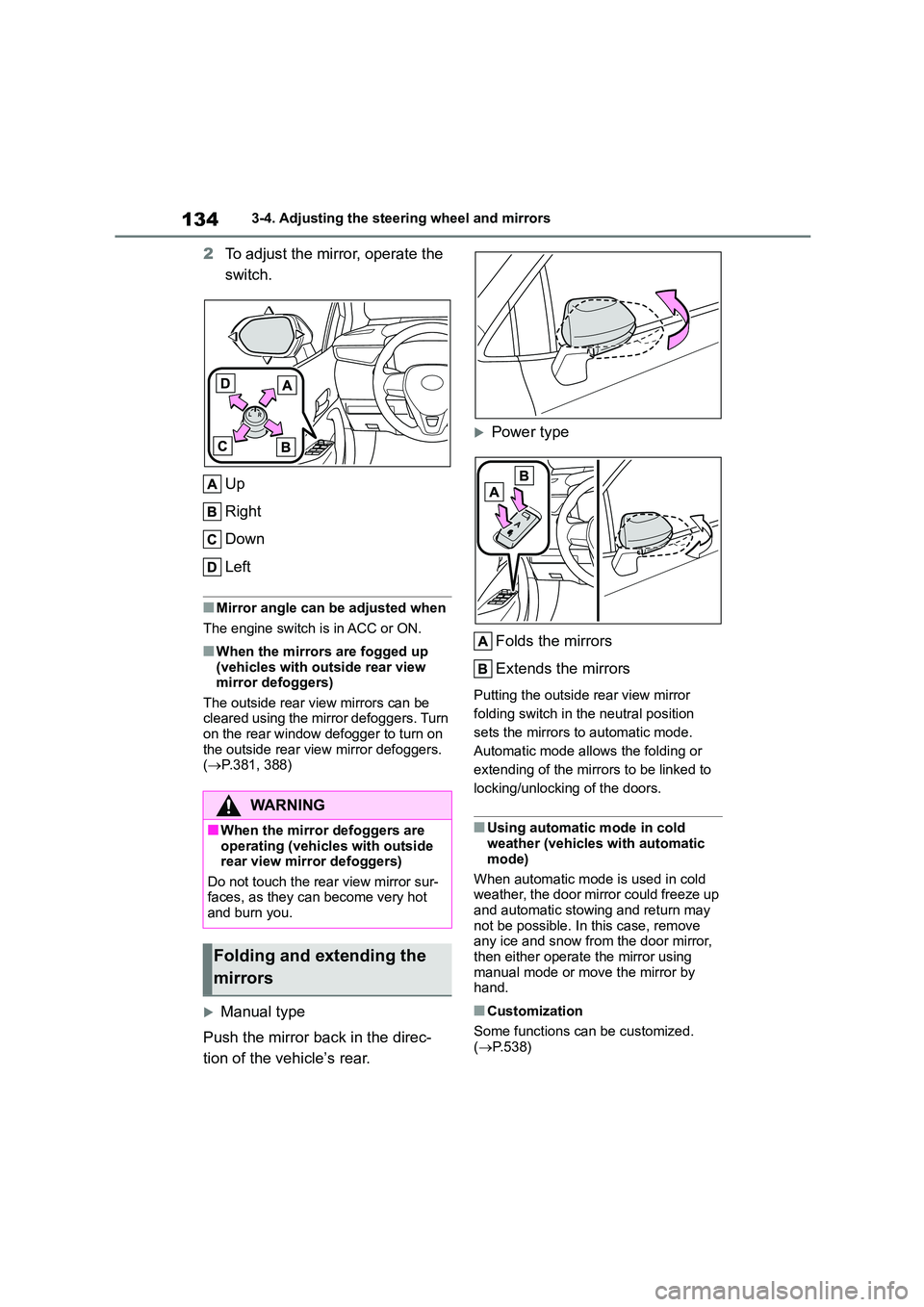
1343-4. Adjusting the steering wheel and mirrors
2To adjust the mirror, operate the
switch.
Up
Right
Down
Left
■Mirror angle can be adjusted when
The engine switch is in ACC or ON.
■When the mirrors are fogged up
(vehicles with outside rear view mirror defoggers)
The outside rear view mirrors can be
cleared using the mirror defoggers. Turn on the rear window defogger to turn on
the outside rear view mirror defoggers.
( P.381, 388)
Manual type
Push the mirror back in the direc-
tion of the vehicle’s rear.
Power type
Folds the mirrors
Extends the mirrors
Putting the outside rear view mirror
folding switch in the neutral position
sets the mirrors to automatic mode.
Automatic mode allows the folding or
extending of the mirrors to be linked to
locking/unlocking of the doors.
■Using automatic mode in cold
weather (vehicles with automatic
mode)
When automatic mode is used in cold weather, the door mirror could freeze up
and automatic stowing and return may
not be possible. In this case, remove any ice and snow from the door mirror,
then either operate the mirror using
manual mode or move the mirror by hand.
■Customization
Some functions can be customized.
( P.538)
WA R N I N G
■When the mirror defoggers are operating (vehicles with outside
rear view mirror defoggers)
Do not touch the rear view mirror sur- faces, as they can become very hot
and burn you.
Folding and extending the
mirrors
Page 145 of 678
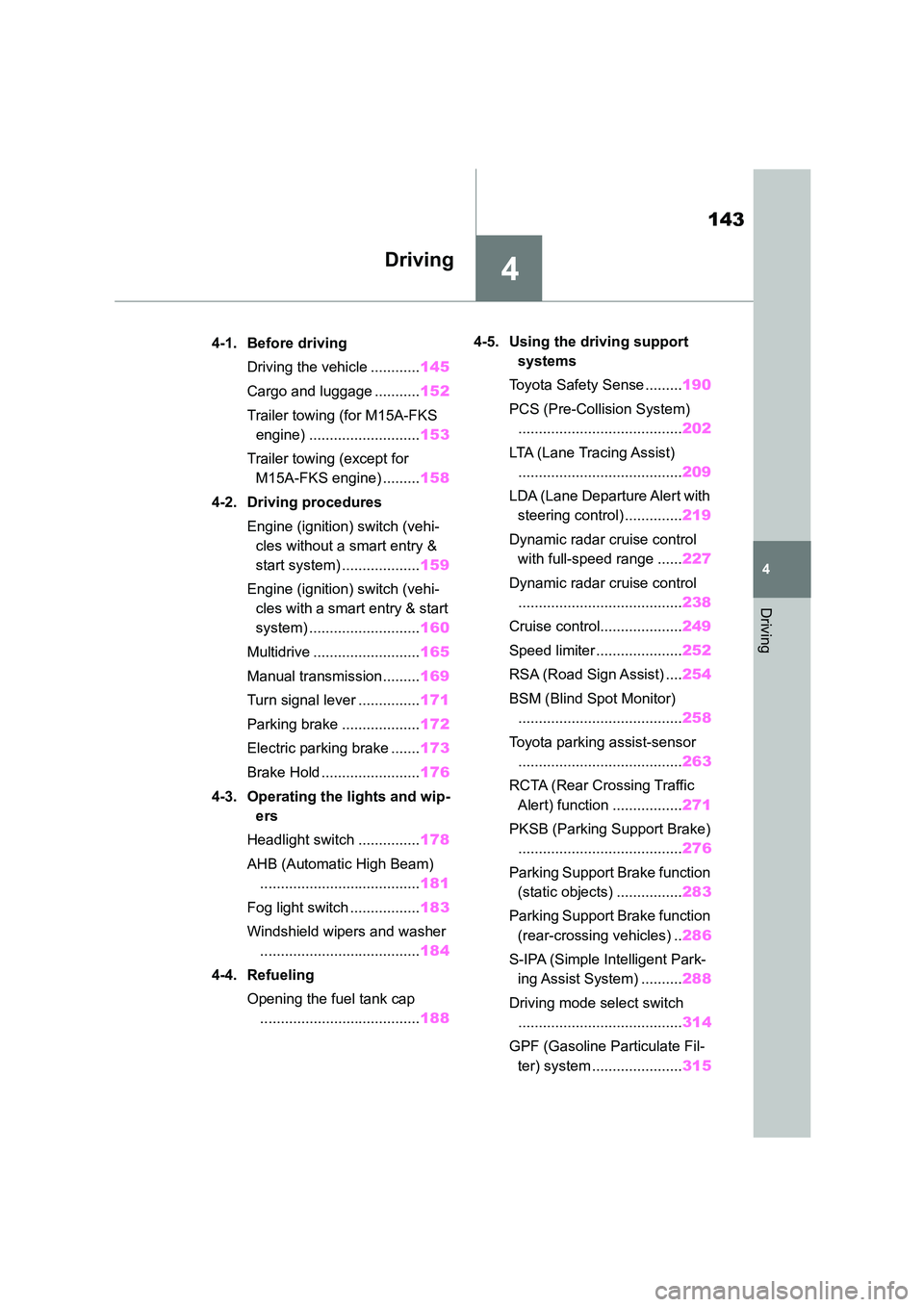
4
143
4
Driving
Driving
.4-1. Before driving
Driving the vehicle ............ 145
Cargo and luggage ........... 152
Trailer towing (for M15A-FKS
engine) ........................... 153
Trailer towing (except for
M15A-FKS engine) ......... 158
4-2. Driving procedures
Engine (ignition) switch (vehi-
cles without a smart entry &
start system) ................... 159
Engine (ignition) switch (vehi-
cles with a smart entry & start
system) ........................... 160
Multidrive .......................... 165
Manual transmission ......... 169
Turn signal lever ............... 171
Parking brake ................... 172
Electric parking brake ....... 173
Brake Hold ........................ 176
4-3. Operating the lights and wip-
ers
Headlight switch ............... 178
AHB (Automatic High Beam)
....................................... 181
Fog light switch ................. 183
Windshield wipers and washer
....................................... 184
4-4. Refueling
Opening the fuel tank cap
....................................... 188
4-5. Using the driving support
systems
Toyota Safety Sense ......... 190
PCS (Pre-Collision System)
........................................ 202
LTA (Lane Tracing Assist)
........................................ 209
LDA (Lane Departure Alert with
steering control) .............. 219
Dynamic radar cruise control
with full-speed range ...... 227
Dynamic radar cruise control
........................................ 238
Cruise control.................... 249
Speed limiter ..................... 252
RSA (Road Sign Assist) .... 254
BSM (Blind Spot Monitor)
........................................ 258
Toyota parking assist-sensor
........................................ 263
RCTA (Rear Crossing Traffic
Alert) function ................. 271
PKSB (Parking Support Brake)
........................................ 276
Parking Support Brake function
(static objects) ................ 283
Parking Support Brake function
(rear-crossing vehicles) .. 286
S-IPA (Simple Intelligent Park-
ing Assist System) .......... 288
Driving mode select switch
........................................ 314
GPF (Gasoline Particulate Fil-
ter) system ...................... 315
Page 155 of 678
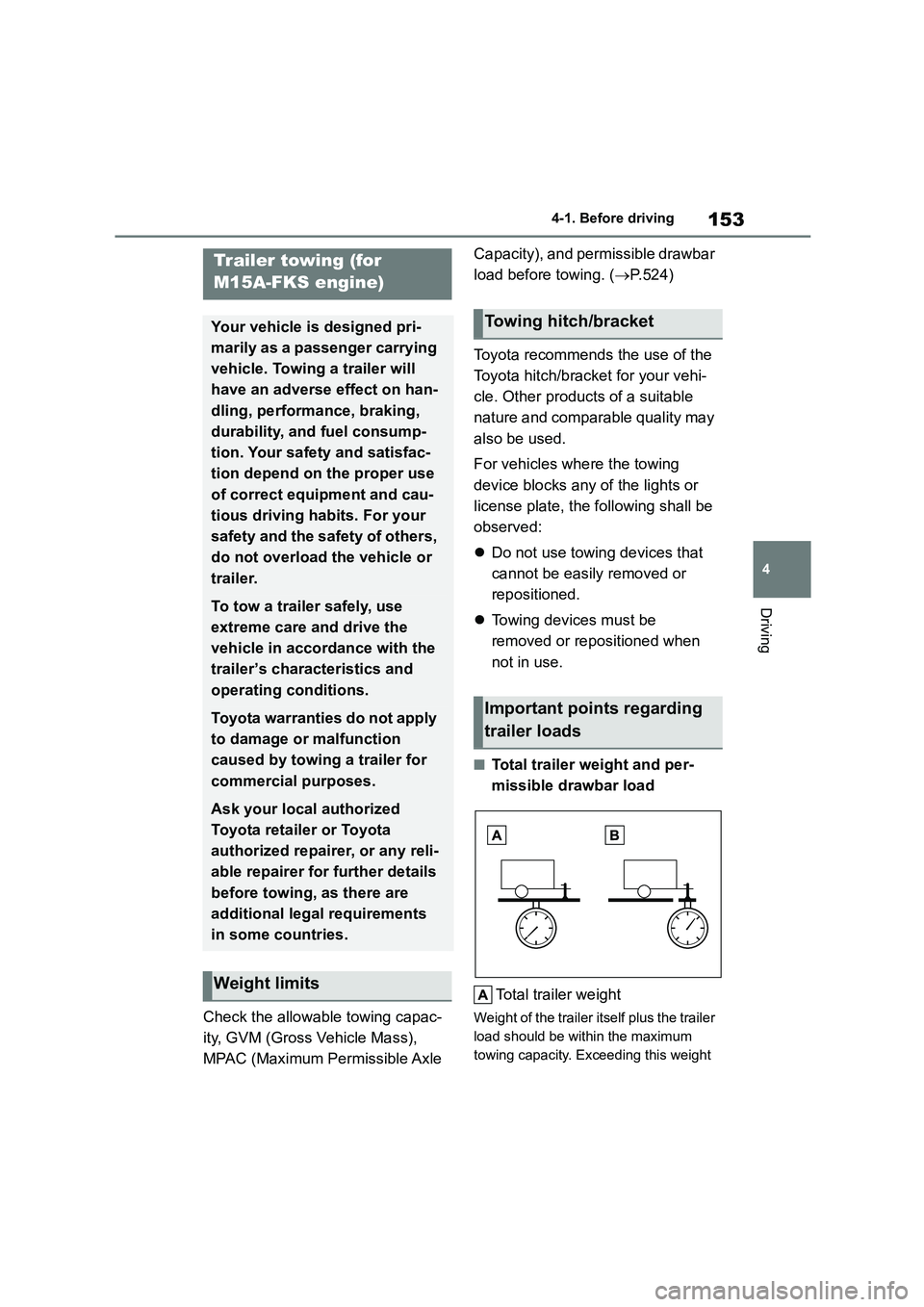
153
4
4-1. Before driving
Driving
Check the allowable towing capac-
ity, GVM (Gross Vehicle Mass),
MPAC (Maximum Permissible Axle
Capacity), and permissible drawbar
load before towing. ( P.524)
Toyota recommends the use of the
Toyota hitch/bracket for your vehi-
cle. Other products of a suitable
nature and comparable quality may
also be used.
For vehicles where the towing
device blocks any of the lights or
license plate, the following shall be
observed:
Do not use towing devices that
cannot be easily removed or
repositioned.
Towing devices must be
removed or repositioned when
not in use.
■Total trailer weight and per-
missible drawbar load
Total trailer weight
Weight of the trailer itself plus the trailer
load should be within the maximum
towing capacity. Exceeding this weight
Trailer towing (for
M15A-FKS engine)
Your vehicle is designed pri-
marily as a passenger carrying
vehicle. Towing a trailer will
have an adverse effect on han-
dling, performance, braking,
durability, and fuel consump-
tion. Your safety and satisfac-
tion depend on the proper use
of correct equipment and cau-
tious driving habits. For your
safety and the safety of others,
do not overload the vehicle or
trailer.
To tow a trailer safely, use
extreme care and drive the
vehicle in accordance with the
trailer’s characteristics and
operating conditions.
Toyota warranties do not apply
to damage or malfunction
caused by towing a trailer for
commercial purposes.
Ask your local authorized
Toyota retailer or Toyota
authorized repairer, or any reli-
able repairer for further details
before towing, as there are
additional legal requirements
in some countries.
Weight limits
Towing hitch/bracket
Important points regarding
trailer loads
Page 156 of 678
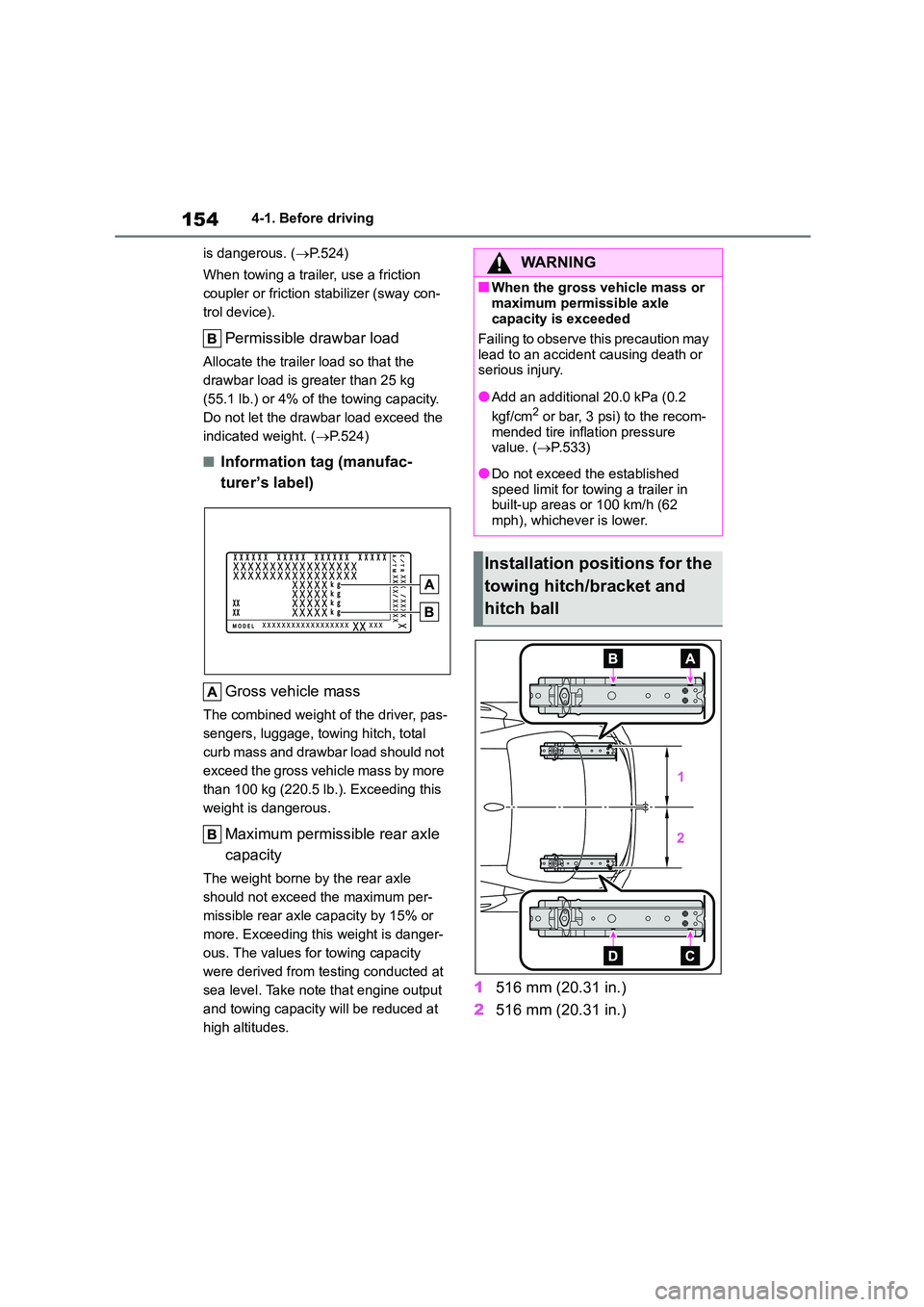
1544-1. Before driving
is dangerous. ( P.524)
When towing a trailer, use a friction
coupler or friction stabilizer (sway con-
trol device).
Permissible drawbar load
Allocate the trailer load so that the
drawbar load is greater than 25 kg
(55.1 lb.) or 4% of the towing capacity.
Do not let the drawbar load exceed the
indicated weight. ( P.524)
■Information tag (manufac-
turer’s label)
Gross vehicle mass
The combined weight of the driver, pas-
sengers, luggage, towing hitch, total
curb mass and drawbar load should not
exceed the gross vehicle mass by more
than 100 kg (220.5 lb.). Exceeding this
weight is dangerous.
Maximum permissible rear axle
capacity
The weight borne by the rear axle
should not exceed the maximum per-
missible rear axle capacity by 15% or
more. Exceeding this weight is danger-
ous. The values for towing capacity
were derived from testing conducted at
sea level. Take note that engine output
and towing capacity will be reduced at
high altitudes.
1 516 mm (20.31 in.)
2 516 mm (20.31 in.)
WA R N I N G
■When the gross vehicle mass or
maximum permissible axle
capacity is exceeded
Failing to observe this precaution may
lead to an accident causing death or
serious injury.
●Add an additional 20.0 kPa (0.2
kgf/cm2 or bar, 3 psi) to the recom-
mended tire inflation pressure
value. ( P.533)
●Do not exceed the established
speed limit for towing a trailer in built-up areas or 100 km/h (62
mph), whichever is lower.
Installation positions for the
towing hitch/bracket and
hitch ball
Page 157 of 678
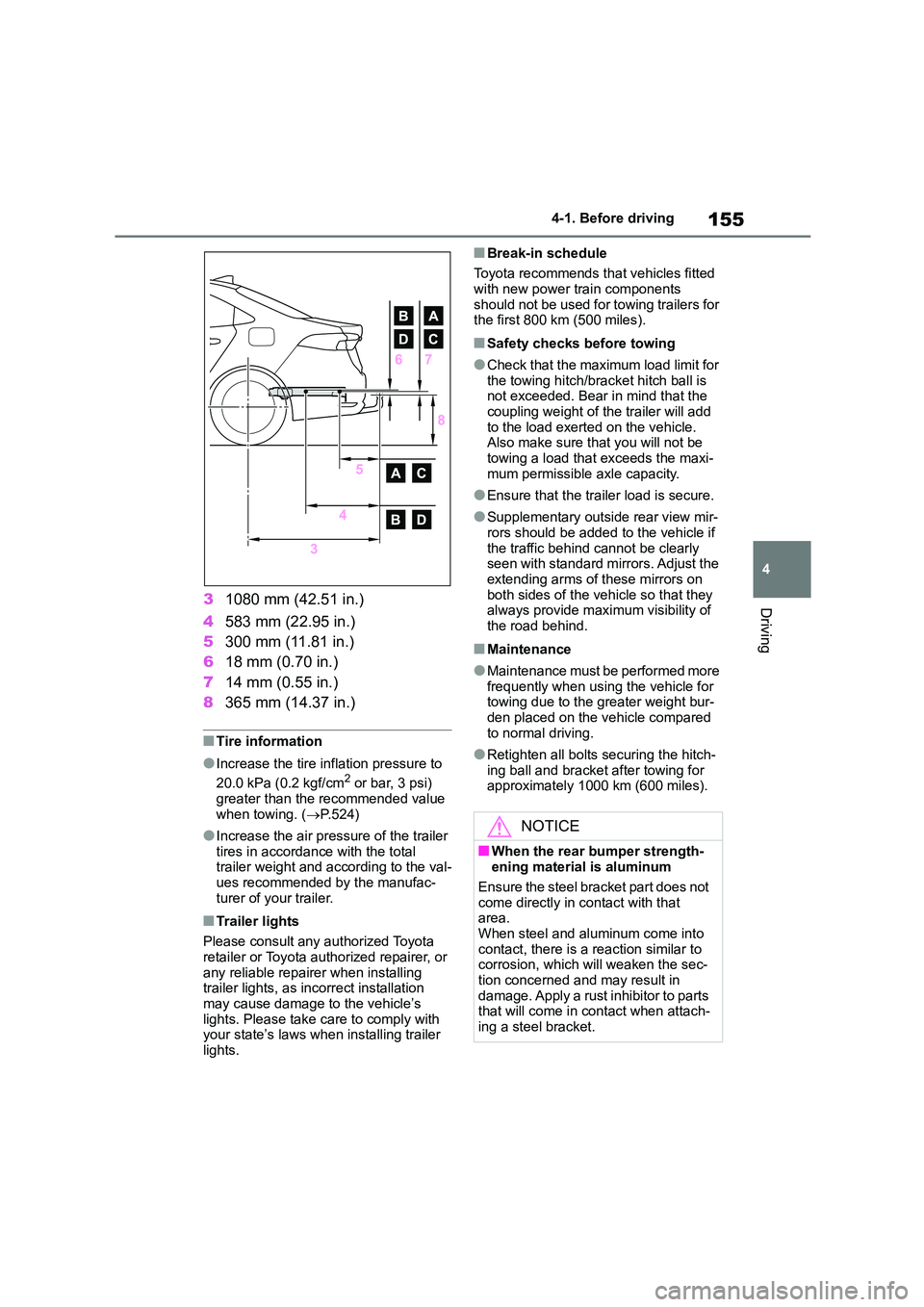
155
4
4-1. Before driving
Driving3 1080 mm (42.51 in.)
4 583 mm (22.95 in.)
5 300 mm (11.81 in.)
6 18 mm (0.70 in.)
7 14 mm (0.55 in.)
8 365 mm (14.37 in.)
■Tire information
●Increase the tire inflation pressure to
20.0 kPa (0.2 kgf/cm2 or bar, 3 psi)
greater than the recommended value when towing. ( P.524)
●Increase the air pressure of the trailer tires in accordance with the total
trailer weight and according to the val-
ues recommended by the manufac- turer of your trailer.
■Trailer lights
Please consult any authorized Toyota
retailer or Toyota authorized repairer, or any reliable repairer when installing
trailer lights, as in correct installation
may cause damage to the vehicle’s lights. Please take care to comply with
your state’s laws when installing trailer
lights.
■Break-in schedule
Toyota recommends that vehicles fitted with new power train components
should not be used for towing trailers for
the first 800 km (500 miles).
■Safety checks before towing
●Check that the maximum load limit for
the towing hitch/bracket hitch ball is not exceeded. Bear in mind that the
coupling weight of the trailer will add
to the load exerted on the vehicle. Also make sure that you will not be
towing a load that exceeds the maxi-
mum permissible axle capacity.
●Ensure that the trailer load is secure.
●Supplementary outside rear view mir-
rors should be added to the vehicle if
the traffic behind cannot be clearly seen with standard mirrors. Adjust the
extending arms of these mirrors on
both sides of the vehicle so that they always provide maximum visibility of
the road behind.
■Maintenance
●Maintenance must be performed more
frequently when using the vehicle for
towing due to the greater weight bur- den placed on the vehicle compared
to normal driving.
●Retighten all bolts securing the hitch-
ing ball and bracket after towing for
approximately 1000 km (600 miles).
NOTICE
■When the rear bumper strength- ening material is aluminum
Ensure the steel bracket part does not
come directly in contact with that area.
When steel and aluminum come into
contact, there is a reaction similar to corrosion, which will weaken the sec-
tion concerned and may result in
damage. Apply a rust inhibitor to parts that will come in contact when attach-
ing a steel bracket.
Page 158 of 678
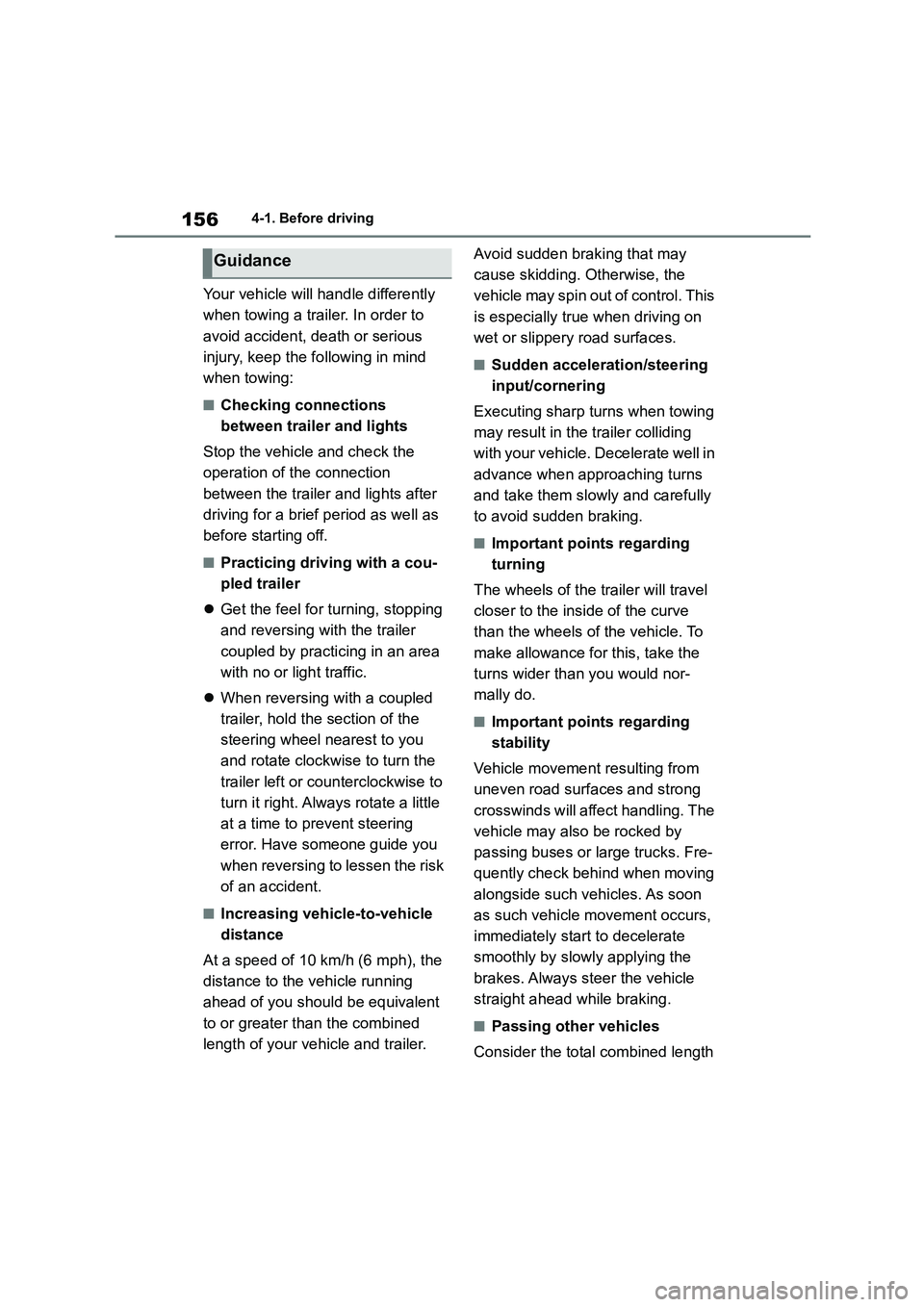
1564-1. Before driving
Your vehicle will handle differently
when towing a trailer. In order to
avoid accident, death or serious
injury, keep the fo llowing in mind
when towing:
■Checking connections
between trailer and lights
Stop the vehicle and check the
operation of the connection
between the trailer and lights after
driving for a brief period as well as
before starting off.
■Practicing driving with a cou-
pled trailer
Get the feel for turning, stopping
and reversing with the trailer
coupled by practicing in an area
with no or light traffic.
When reversing with a coupled
trailer, hold the section of the
steering wheel nearest to you
and rotate clockw ise to turn the
trailer left or counterclockwise to
turn it right. Always rotate a little
at a time to prevent steering
error. Have someone guide you
when reversing to lessen the risk
of an accident.
■Increasing vehicle-to-vehicle
distance
At a speed of 10 km/h (6 mph), the
distance to the vehicle running
ahead of you should be equivalent
to or greater than the combined
length of your vehicle and trailer.
Avoid sudden braking that may
cause skidding. Otherwise, the
vehicle may spin out of control. This
is especially true when driving on
wet or slippery road surfaces.
■Sudden acceleration/steering
input/cornering
Executing sharp turns when towing
may result in th e trailer colliding
with your vehicle. Decelerate well in
advance when approaching turns
and take them slowly and carefully
to avoid sudden braking.
■Important points regarding
turning
The wheels of the tr ailer will travel
closer to the inside of the curve
than the wheels of the vehicle. To
make allowance for this, take the
turns wider than you would nor-
mally do.
■Important points regarding
stability
Vehicle movement resulting from
uneven road surfaces and strong
crosswinds will affect handling. The
vehicle may also be rocked by
passing buses or large trucks. Fre-
quently check behind when moving
alongside such vehicles. As soon
as such vehicle movement occurs,
immediately start to decelerate
smoothly by slowly applying the
brakes. Always steer the vehicle
straight ahead while braking.
■Passing other vehicles
Consider the total combined length
Guidance